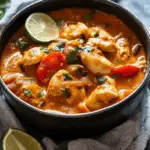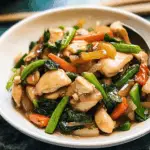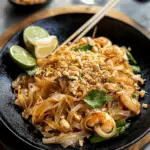Chicken Pad Thai is a classic Thai street food that combines savory, sweet, sour, and spicy flavors into one delightful dish. With tender chicken, soft rice noodles, and a crunchy topping of peanuts and fresh herbs, every bite is packed with a burst of flavor.
The beauty of this recipe lies in its balance. You get the richness of the tamarind sauce, the brightness of lime juice, and the heat from chili flakes, all tied together with the satisfying crunch of peanuts. Whether you’re looking for a quick meal to impress your friends or a cozy dinner at home, this dish has it all – it’s simple, customizable, and absolutely delicious!
Full Recipe:
-
300g chicken breast, sliced into thin strips
-
200g rice noodles
-
2 tablespoons vegetable oil
-
1 onion, finely chopped
-
2 cloves garlic, minced
-
1 carrot, julienned
-
2 eggs, lightly beaten
-
1/4 cup fish sauce
-
2 tablespoons brown sugar
-
2 tablespoons lime juice
-
1 tablespoon tamarind paste
-
1/4 cup roasted peanuts, crushed
-
1/4 cup fresh cilantro, chopped
-
2 spring onions, chopped
-
1/4 teaspoon chili flakes (optional)
-
Salt and pepper to taste
Directions:
-
Cook the rice noodles according to package instructions. Drain and set aside.
-
Heat the vegetable oil in a wok or large skillet over medium-high heat. Add the chicken and cook until browned and cooked through, about 5-6 minutes. Remove from the skillet and set aside.
-
In the same skillet, add the onion and garlic. Sauté for 2-3 minutes until fragrant.
-
Add the julienned carrot and cook for another 2-3 minutes, stirring occasionally.
-
Push the vegetables to one side of the skillet and pour the beaten eggs into the empty side. Scramble until cooked through, then mix with the vegetables.
-
In a small bowl, combine the fish sauce, brown sugar, lime juice, and tamarind paste. Add the sauce mixture to the skillet and stir to combine.
-
Add the cooked noodles and chicken back to the skillet and toss everything together until well coated.
-
Remove from heat and garnish with roasted peanuts, cilantro, spring onions, and optional chili flakes.
-
Serve hot and enjoy your flavorful homemade Chicken Pad Thai!
Prep Time: 15 minutes | Cooking Time: 15 minutes | Total Time: 30 minutes
Kcal: 450 kcal | Servings: 2 servings
The Origins and History of Chicken Pad Thai
Chicken Pad Thai is a beloved Thai street food that has captured the hearts of people worldwide. The dish is part of the famous Pad Thai family, which is known for its bold and savory flavors. While the exact origin of Pad Thai is somewhat debated, it is widely believed to have been created during the 1930s to 1940s in Thailand. During this time, the Thai government wanted to promote a sense of unity and national identity. One way they did this was by encouraging the population to eat noodle dishes that incorporated indigenous ingredients, thus creating Pad Thai.
Though its roots are firmly planted in Thailand, Pad Thai has evolved into an international dish. Today, it is commonly enjoyed in restaurants worldwide, often tailored to local tastes, such as the inclusion of chicken, shrimp, or tofu.
The Flavors of Chicken Pad Thai
What makes Chicken Pad Thai so irresistible is its perfect balance of flavors. The dish combines sweet, salty, sour, and spicy notes that create a harmonious and complex flavor profile. The tamarind paste provides a tangy and slightly sweet flavor, while the fish sauce brings a salty, umami depth. Lime juice adds brightness and acidity, cutting through the richness of the stir-fried noodles and chicken. The addition of chili flakes brings a touch of heat, which can be adjusted based on personal preference.
This dish also features a variety of textures, with the chewy rice noodles, crispy peanuts, and tender chicken all adding to the satisfying experience of each bite. The fresh cilantro, spring onions, and lime wedges that garnish the dish offer an additional layer of freshness and fragrance, making Chicken Pad Thai not only a treat for the taste buds but also visually appealing.
Different Variations of Pad Thai
While Chicken Pad Thai is a popular version of the dish, there are many other variations that cater to different dietary preferences and regional tastes. Common substitutions for the chicken include shrimp, beef, or tofu, making the dish customizable for both meat lovers and vegetarians.
In some regions, Pad Thai is made with a sweeter or spicier sauce, depending on the local palate. Some versions may also incorporate additional vegetables, such as bell peppers, mushrooms, or bean sprouts, for added crunch and nutrition.
A growing trend is the use of gluten-free noodles, catering to those who follow gluten-free diets or have gluten sensitivities. Furthermore, for a lower-carb option, some cooks swap rice noodles for spiralized zucchini or other vegetables, making the dish even more versatile.
The Health Benefits of Chicken Pad Thai
Despite being a street food often associated with indulgence, Chicken Pad Thai can be a relatively healthy meal, especially when prepared at home with fresh ingredients. The dish offers a good balance of protein, carbs, and healthy fats. Chicken provides lean protein, while peanuts contribute healthy fats and additional protein. The tamarind paste is a source of antioxidants, and the lime juice adds vitamin C to help boost immunity.
For those looking to reduce calories, the amount of oil used in the recipe can be minimized, or healthier oils such as olive oil can be substituted. The dish also allows room for vegetable inclusion, which can increase fiber intake and provide important vitamins and minerals.
By making Chicken Pad Thai at home, you can control the ingredients, making it a healthier alternative to the often greasy versions found in many restaurants.
Serving Suggestions for Chicken Pad Thai
Chicken Pad Thai is a complete meal on its own, but it can also be served alongside complementary dishes to create a well-rounded feast. Pairing it with a refreshing Thai salad, such as a papaya or mango salad, can add a crisp contrast to the rich flavors of the Pad Thai. For a more substantial meal, you could serve it with Thai spring rolls, either fresh or fried, for an appetizer.
In addition to the traditional garnishes of crushed peanuts, lime wedges, and fresh cilantro, some people enjoy adding a sprinkle of chili powder or a drizzle of extra fish sauce for an added punch of flavor. For those who enjoy a more robust spice level, a side of Sriracha sauce can complement the dish perfectly.
Chicken Pad Thai also works wonderfully as a meal prep option. Since it is easy to make in large batches, it can be stored in the refrigerator for a couple of days, making it a convenient option for lunches or quick weeknight dinners.
The Popularity of Chicken Pad Thai Worldwide
Over the years, Chicken Pad Thai has become a popular dish in Thai restaurants and home kitchens around the world. Its combination of flavors and textures, along with its adaptability, has made it a favorite among food lovers of all backgrounds. Whether enjoyed as a casual weeknight meal or served at a dinner party, Chicken Pad Thai has earned its place as one of the most iconic dishes in Thai cuisine.
Its global reach is a testament to the versatility and appeal of Pad Thai. From its humble beginnings as a street food in Thailand, it has become a dish that is both accessible and celebrated in many countries.
Conclusion
Chicken Pad Thai is a vibrant and flavorful dish that brings together a variety of ingredients, flavors, and textures into one satisfying meal. Whether you’re enjoying it as a quick weeknight dinner, serving it at a gathering, or customizing it to suit your dietary needs, this dish continues to be a favorite worldwide. With its perfect balance of savory, sweet, sour, and spicy elements, Chicken Pad Thai is a dish that appeals to a wide range of tastes and is sure to impress anyone who tries it.
By preparing Chicken Pad Thai at home, you can not only enjoy this classic Thai dish but also experiment with variations that suit your preferences. With its rich history, complex flavors, and endless customization options, Chicken Pad Thai is a dish that will always have a place on your dining table.






